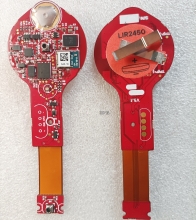- PCB Blog
- PCB Assembly Blog
- About PCB Assembly
- QFP and BGA and the Development Trend in PCB assembly
- Why some components need be baked before reflow soldering
- About Flex PCB Assembly
- Manual Soldering in SMT Assembly Manufacturing Process
- BGA Components and BGA Assembly
- Quick Understanding for PCB Assembly Process
- About SMT Assembly (Surface Mount Technology)
- About THT Assembly (Through-Hole Technology)
- About Reflow Soldering
- About_Wave_Soldering
- PCB Assembly Inspections and Tests
- Panel Requirements for PCB Assembly
- About SMT (Surface Mount Technology)
In the early stage, all PCBs were assembled with components by hand using only a solder iron. With the development of technology, components size on PCB boards getting smaller and smaller, and the components quantity getting more and more. It become more difficult to assemble by hand and impossible task for big production order. Thus auto SMT assembly and auto THT assembly was developed as well.
Materials Preparation
1. PCB (print circuit board):
Order PCB boards with SemiPCB. All PCB boards will pass strict tests before assembly.
2. Components:
Order components with SemiPCB, or provide Components to us for assembly. We will make sure the components are new and original.
3. PCB Stencil and Solder Paste:
We will do SMD stencils for PCB assembly order. It would be lasered-cut in high quality to ensure the apertures were opened correctly. Take out the solder paste from the freezer, It needs thawing, stirring.
4. Files Checking:
Check all files (Gerber file, BOM list, assembly drawing, pick&place file) are ready and no problem on the desk.
5. Tools:
Soldering iron, tin, wire stripper, component box, torch, pliers, heat gun and so on.
Bare Board Baking:
Ensure the dryness of PCB, or the PCB may have bubbles or delaminate issues after reflow-soldering oven.
Solder Paste Printing:
Setting the SMD stencil on the auto-print solder paste machine and ensure the solder paste be accurately printed on PCB pads.
Pre-Soldering Inspection:
Inspect the solder paste were accurately printed on PCB pads.
High Speed Mounting:
The high speed mounting machine could pick & place the components very quickly and accurately on the PCB pads.
Inspection Before Re-Flow:
Inspect the boards and ensure that the parts were mounted corretly.
Re-Flow Soldering:
Put the boards on the rail of the re-flow soldering oven. The boards would go through a temperature curve to heat the boards slowly and then cooling slowly. Summarizely, it has drying area, preheating area, welding area, and cooling zone.
AOI inspection:
After SMD Assembly done (i.e. PCB boards go through reflow soldering oven), the AOI will be applied to detect the soldering of the PCB, ensure no parts missing, no parts in wrong orientation, no short, no soldering false, etc.
THT Assembly:
It normally could be done by hand and shall be done after SMD Assembly. The staffs would plug-in DIP parts and then soldering the part legs on the PCB boards directly. If the quantity is big, it may also need be done by auto-plug machine, and soldering by Wave Soldering Oven.
Wave Soldering:
Put the boards plugged with DIP parts into the wave soldering, the soldering of PCBA board is achieved through the spray welding flux, preheat, wave peak soldering, cooling, etc.
Cleaning:
To make sure there is no defects on the board after wave soldering, which usually needs to be washed.
ICT/FCT:
Generally, the PCBA board should be ICT, FCT, aging test and program burning, in order to ensure the normal operation of the PCBA function and reduce the rework rate in the later period.
Final Quality Checking:
The finished product needs to be sent to the quality inspection department for quality checking, make sure there is no quality issue before packing.
Packing:
Coming to the last part, we use anti-static material to pack the PCBA boards to avoid ESD damage to the components.
The above is the quick process of standard PCB assembly. We believe that you can quickly understand how PCB Assembly work after you read it.
